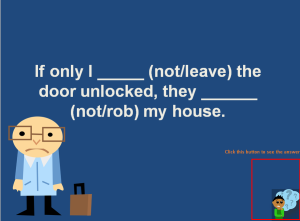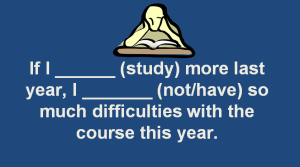Category Archives: Conditional Sentences
Conditional sentences, type 0, 1 and 3 – Grammar game
| CONDITIONAL BATTLE FIELD | |
| Aim | To practise the use of conditional sentences type 0, 1 and 2 |
| Interaction | Groups of 3, 4 or 5 students |
| Exercise type: | Filling in the gaps, correcting mistakes |
| Language: | B1 |
| Time: | 15 – 25 minutes |
| Materials: | A marker and a whiteboard, a set of question cards for the class. |
| Procedure: |
|
The game is available from download from Slideshare and here >>> CONDITIONAL BATTLE FIELD
Conditional Sentences – Grammar Game
The aim of the game is to practice the use of conditional sentences type 0, 1 , 2, and 3 as well as mixed conditionals.
The game is designed for upper-intermediate students, but you can easily modify the questions.
The game includes three types of questions:
1. Filling in the gaps, where players need to put the verbs in brackets in the correct form (Fill category);
2. Finding and correcting mistakes. Each sentence in this category has a mistake or two in the use of conditional sentences, the task is to find the mistake(s) and to correct it/them (Fix category);
3. Choosing the most suitable option out of two (Choose category).
The game has a main screen with a Jeopardy board, the students select the type of question and its value (more difficult questions value more) and click on a corresponding button.
This will take a student to a question slide. When the students give their answer, click on the question mark button in the bottom righ-hand corner, this will take you to an answer screen.

On the answer screen, click on the house icon to return to the main screen with the jeopady board.
Have fun learning and teaching!
Click here to download the editable Conditional Sentences Grammar Game > Conditional Sentences Jeopardy 1, 2, 3
Wacky stories – Comminucative ESL Game to practise vocabulary and tenses.
| Wacky Stories | |
| Aim: | To practice vocabulary, all 12 tenses and conditional sentences (adjustable). To practice storytelling techniques (building suspense, flash-backs, flash-forwards, etc.) |
| Interaction: | Groups of three or four |
| Exercise type: | Speaking, storytelling |
| Time: | 15 minutes |
| Language: | Depends on the level of Students |
| Level: | A2 – C2 |
| Materials: | 1 set, cut up per group (the set can include as many cards as you decide and may vary depending on the level of the students). |
| Procedure: | In this activity the students make a chain story, using the words and images on the cards, as well as the tenses or grammar structures indicated on them. With a little imagination and sense of humor from your students this game can get hilarious. If you want to emphasize the use of tenses and grammar structures, there is an extra tense component on each card, this component instructs the students not only to use a noun, a verb or an adjective on the card but to construct the sentence in a certain tense. This can bring into the story flash-backs and flash-forwards (so you may need to pre-teach these storytelling techniques first).
|
The printable handout can be downloaded here >> Wacky Stories – Comminucative ESL Game
The game is also available for download on slideshare:







